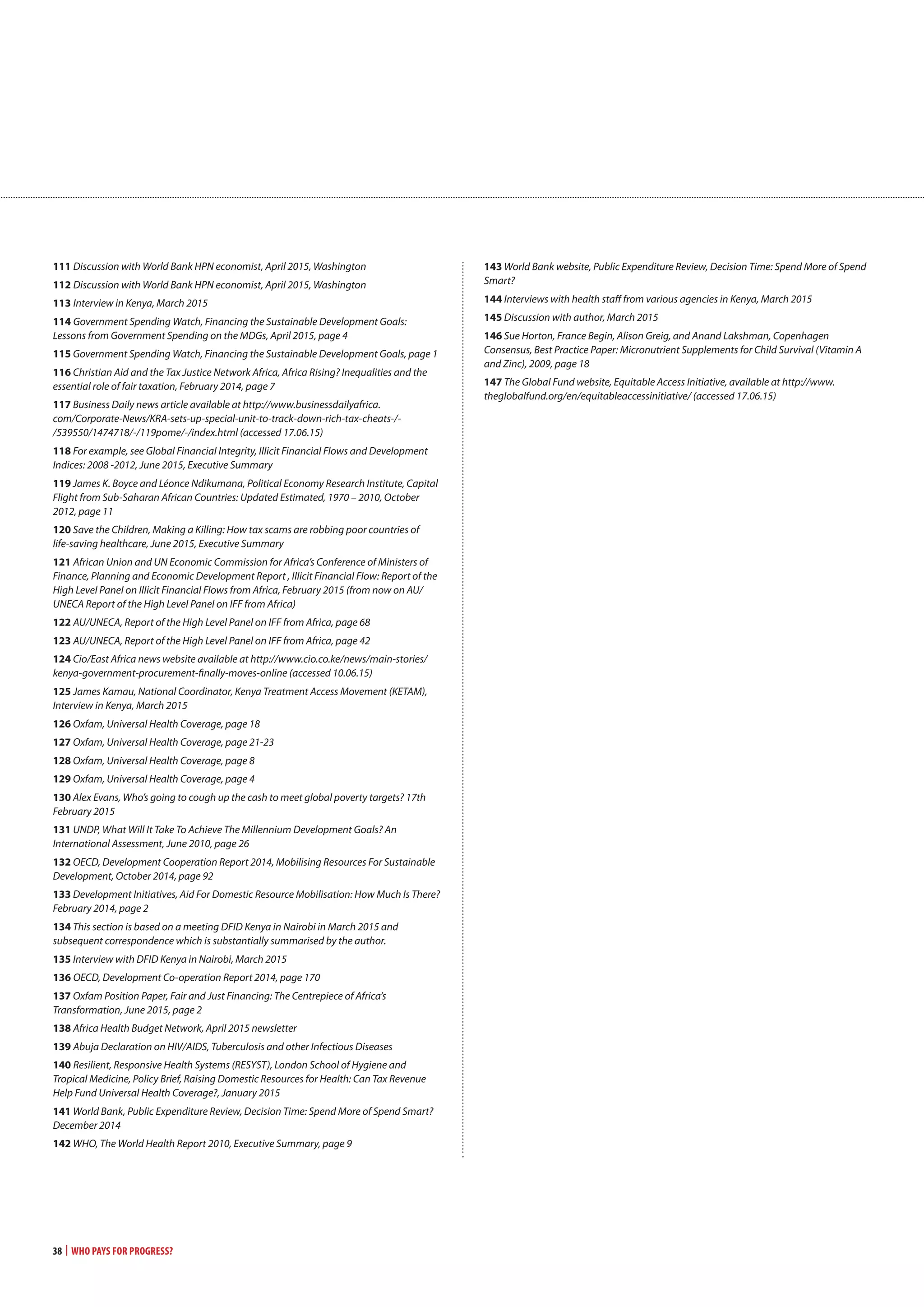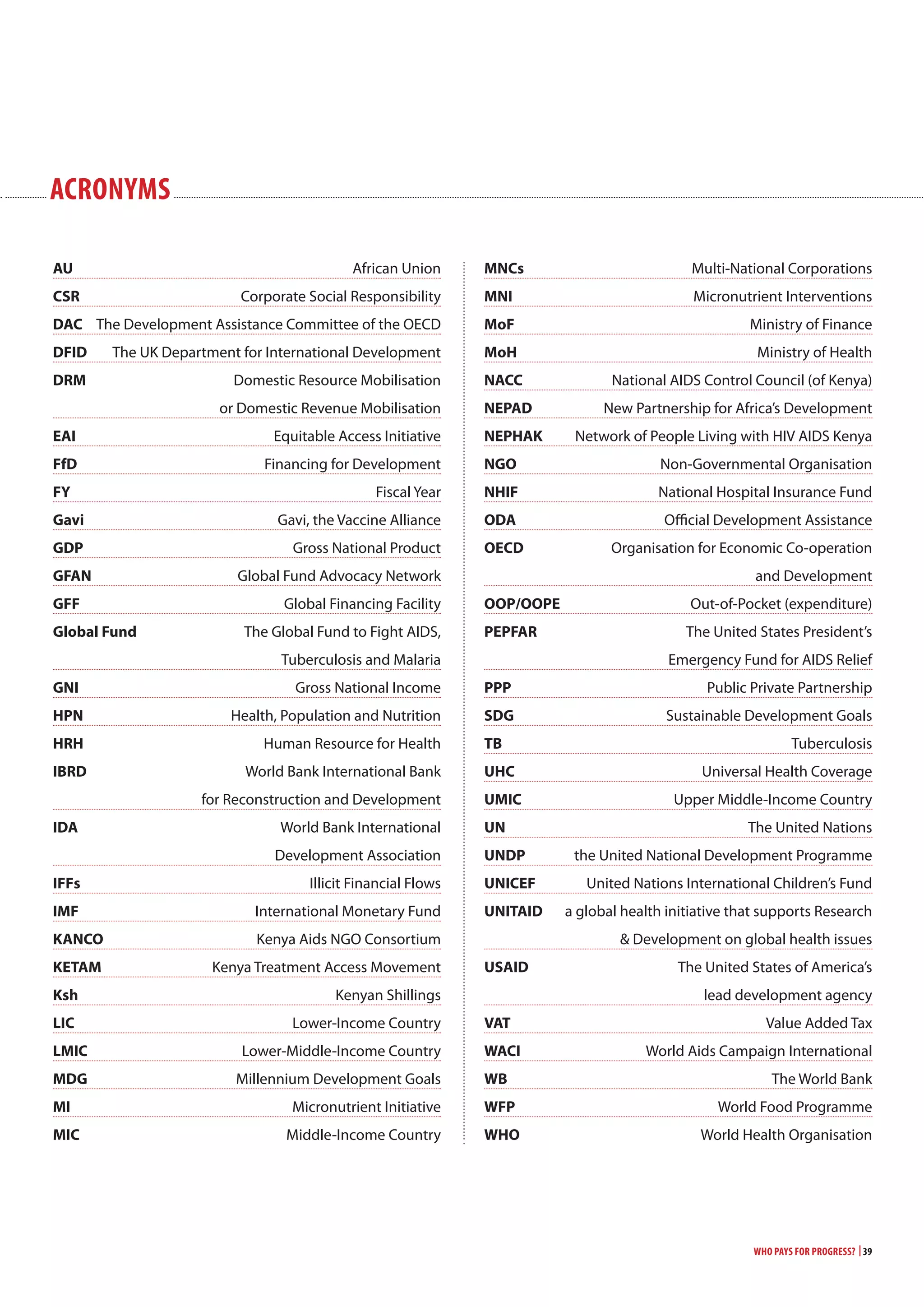Kenya has transitioned to lower-middle income status but still faces health challenges, with 43% living on less than $1.25 per day and poor coverage and access in some areas. The report examines financing options for health in Kenya as it aims to achieve universal health coverage. It looks at the balance between domestic resource mobilization and funding from donors, finding that both will be needed to close funding gaps and reduce the unmet need for health services. Recommendations include increasing domestic revenues through taxes and efficiency while donors avoid withdrawing support too quickly as most developing countries will still need assistance for many years.

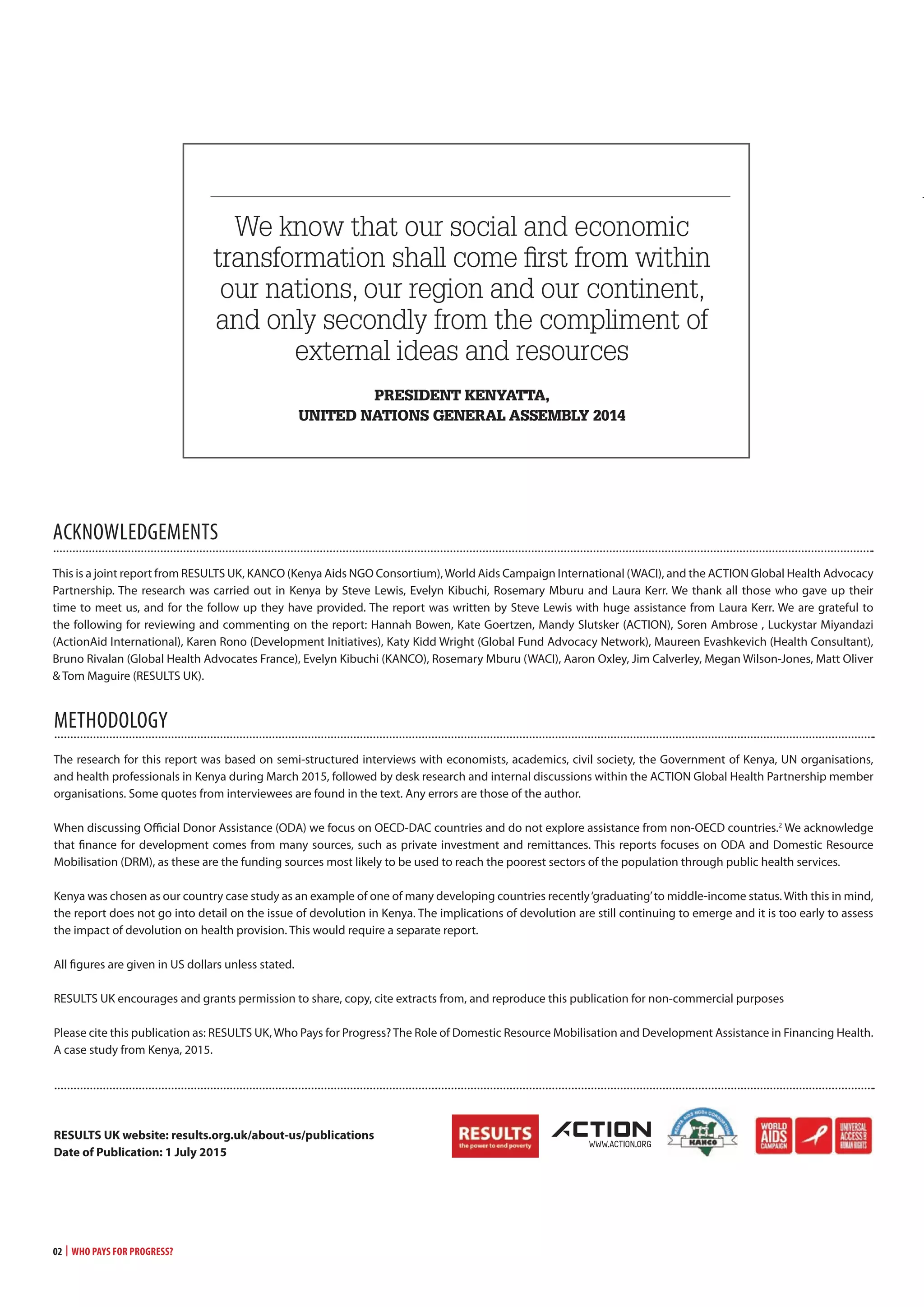
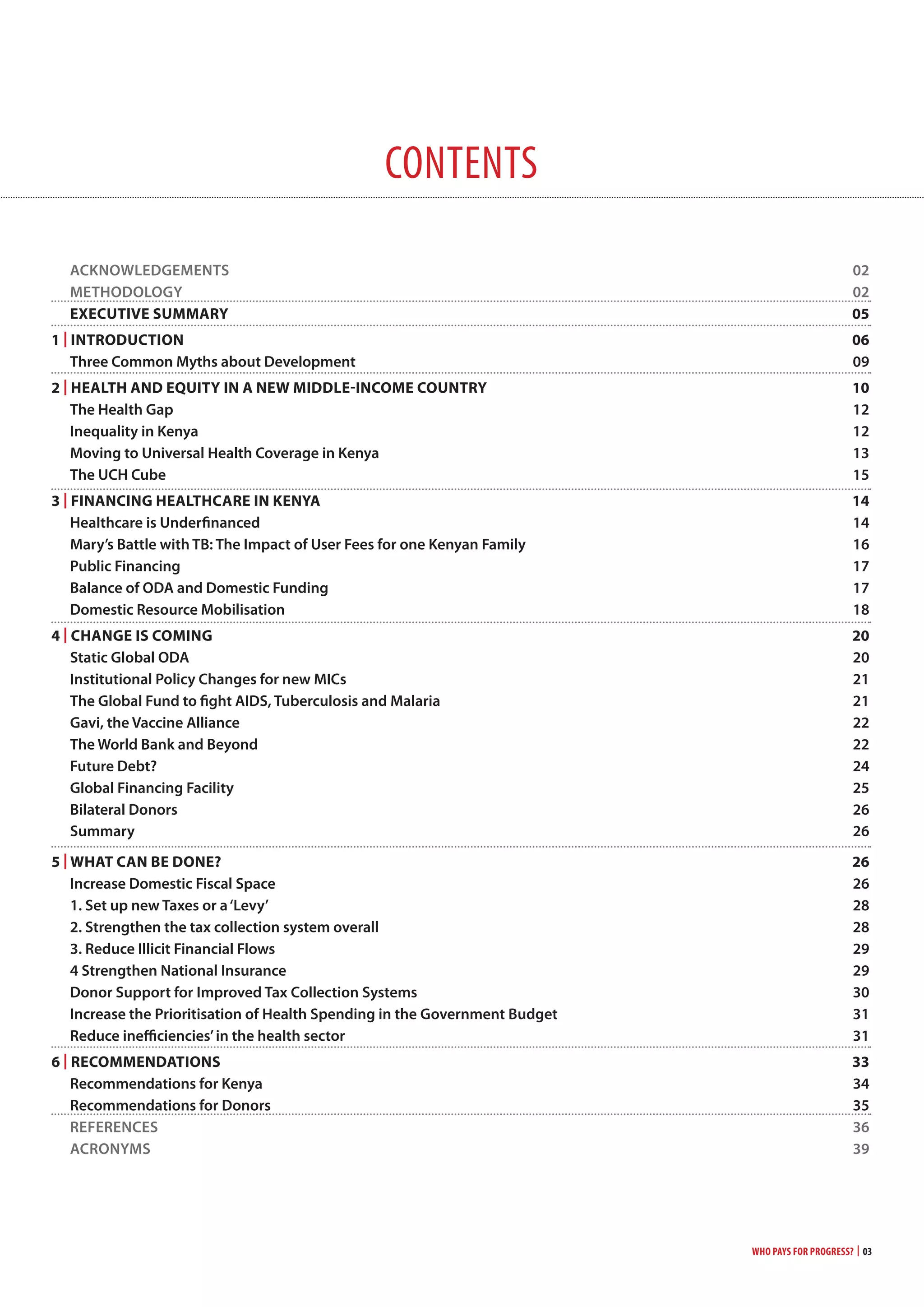
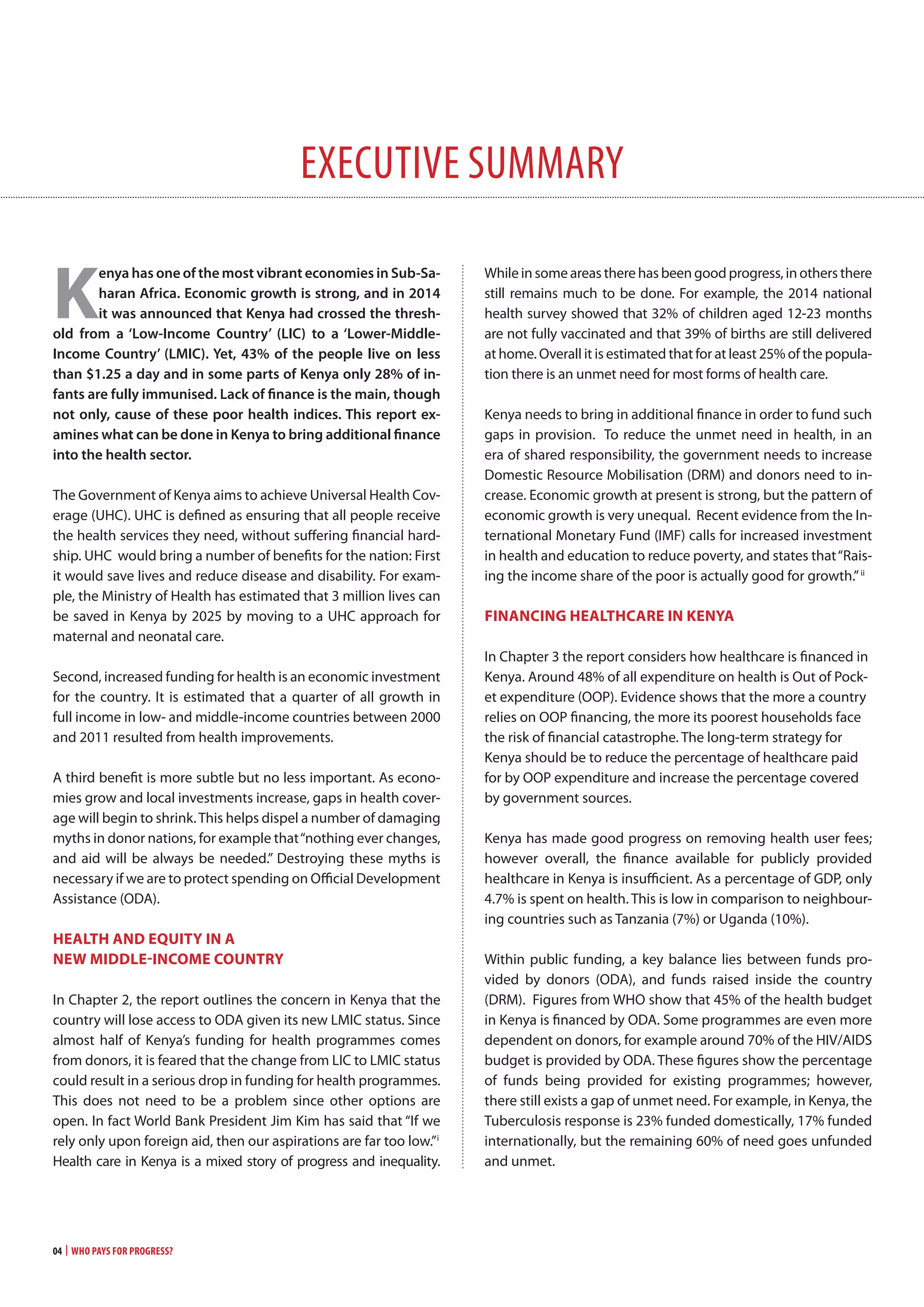
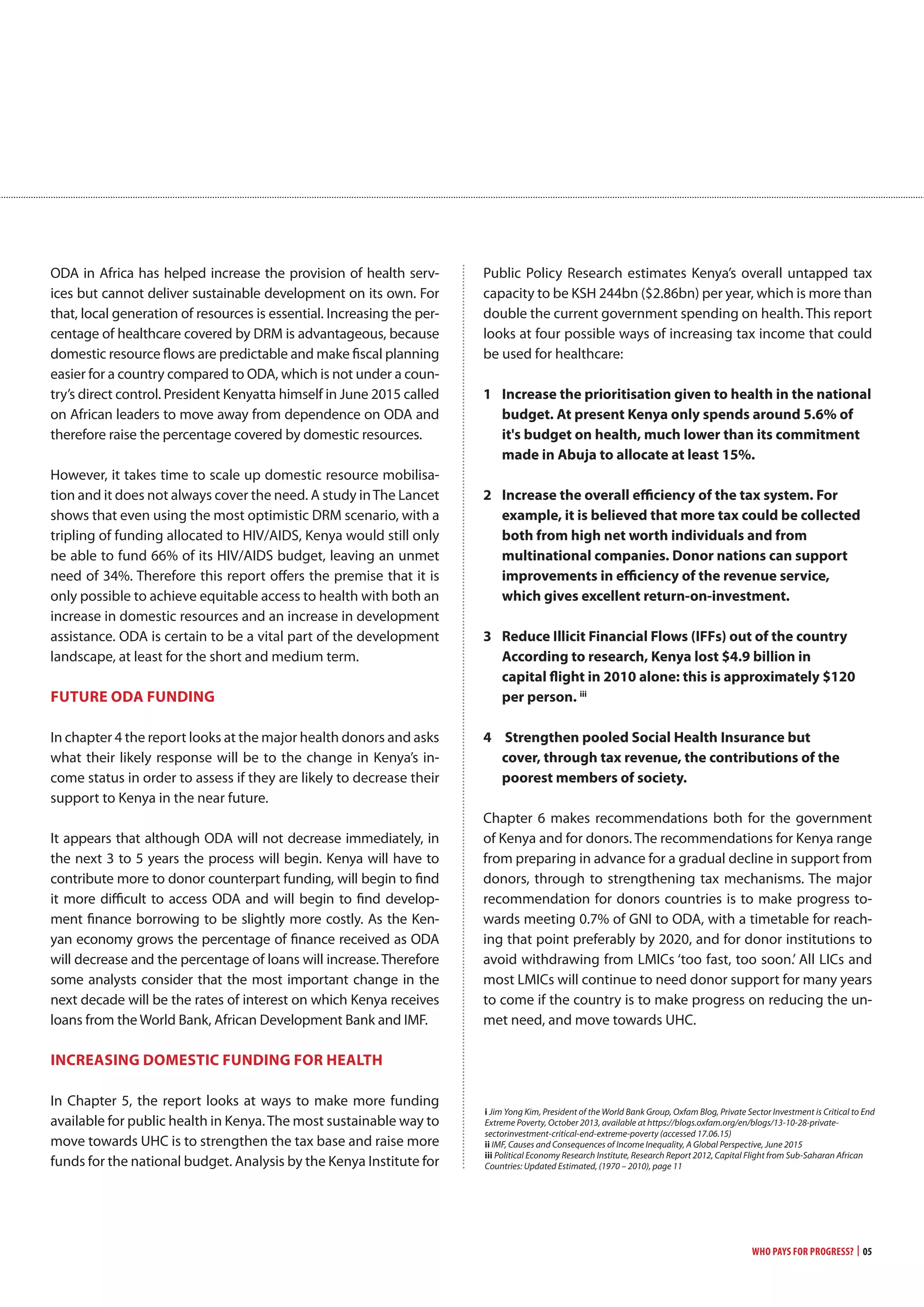

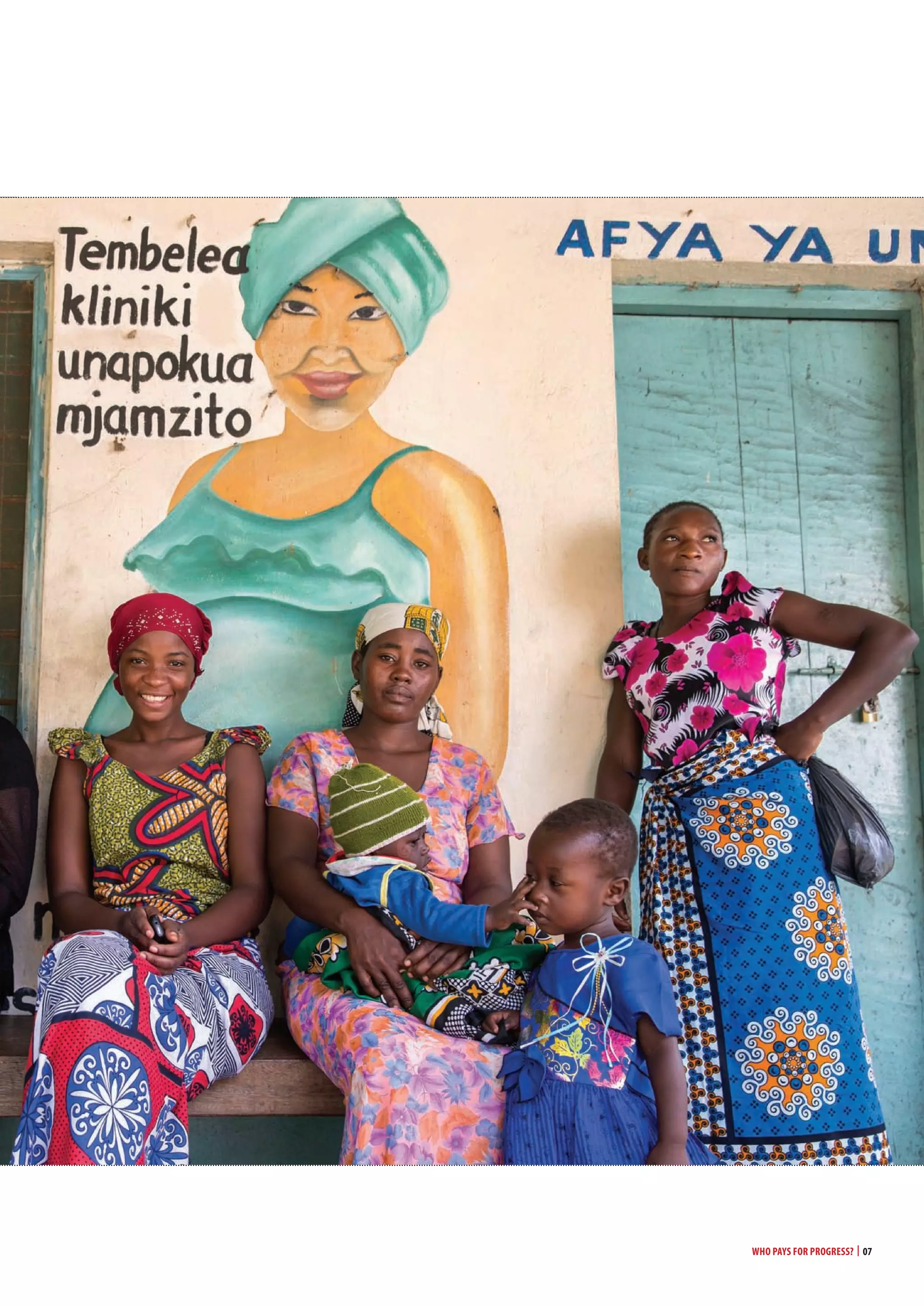
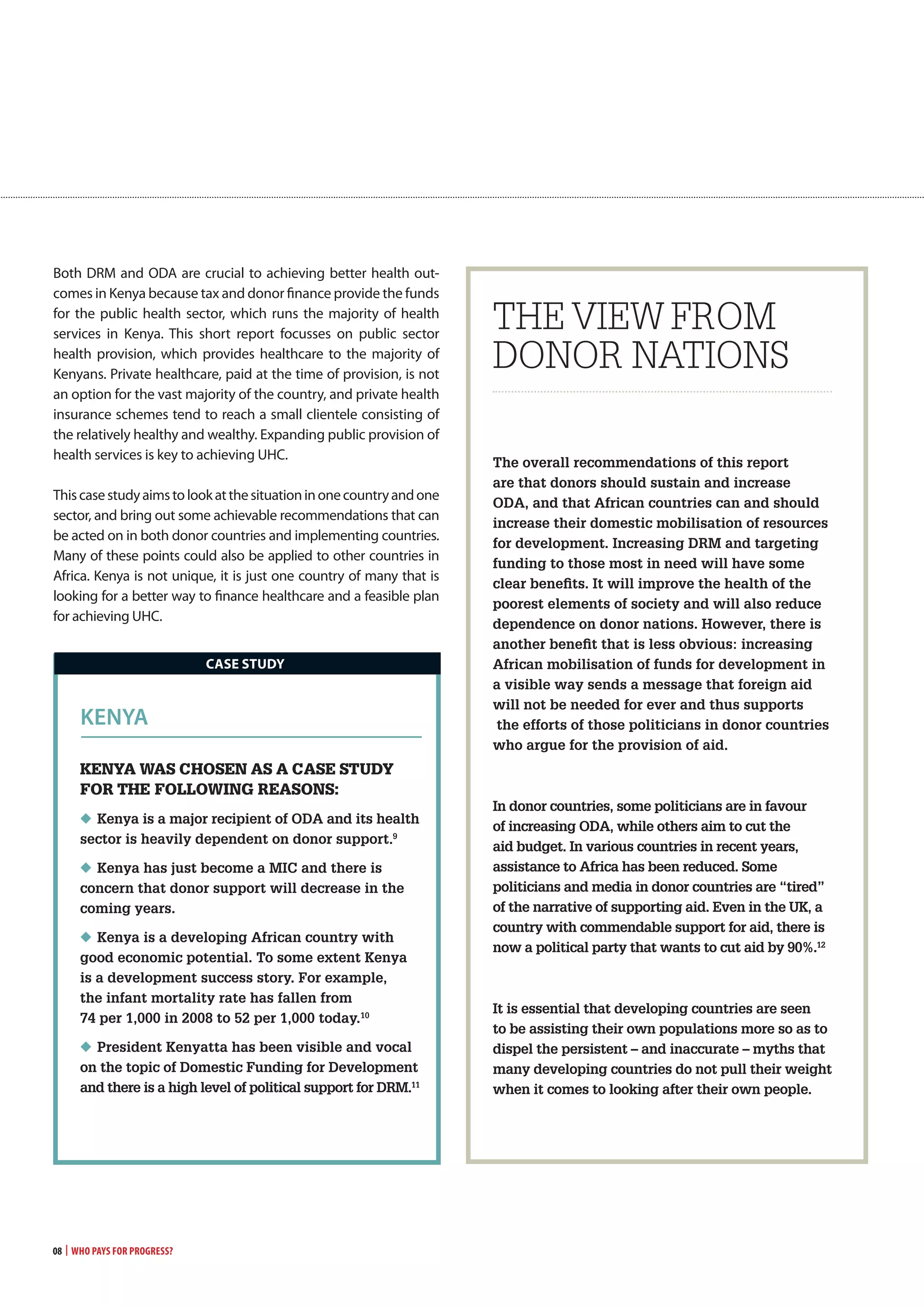
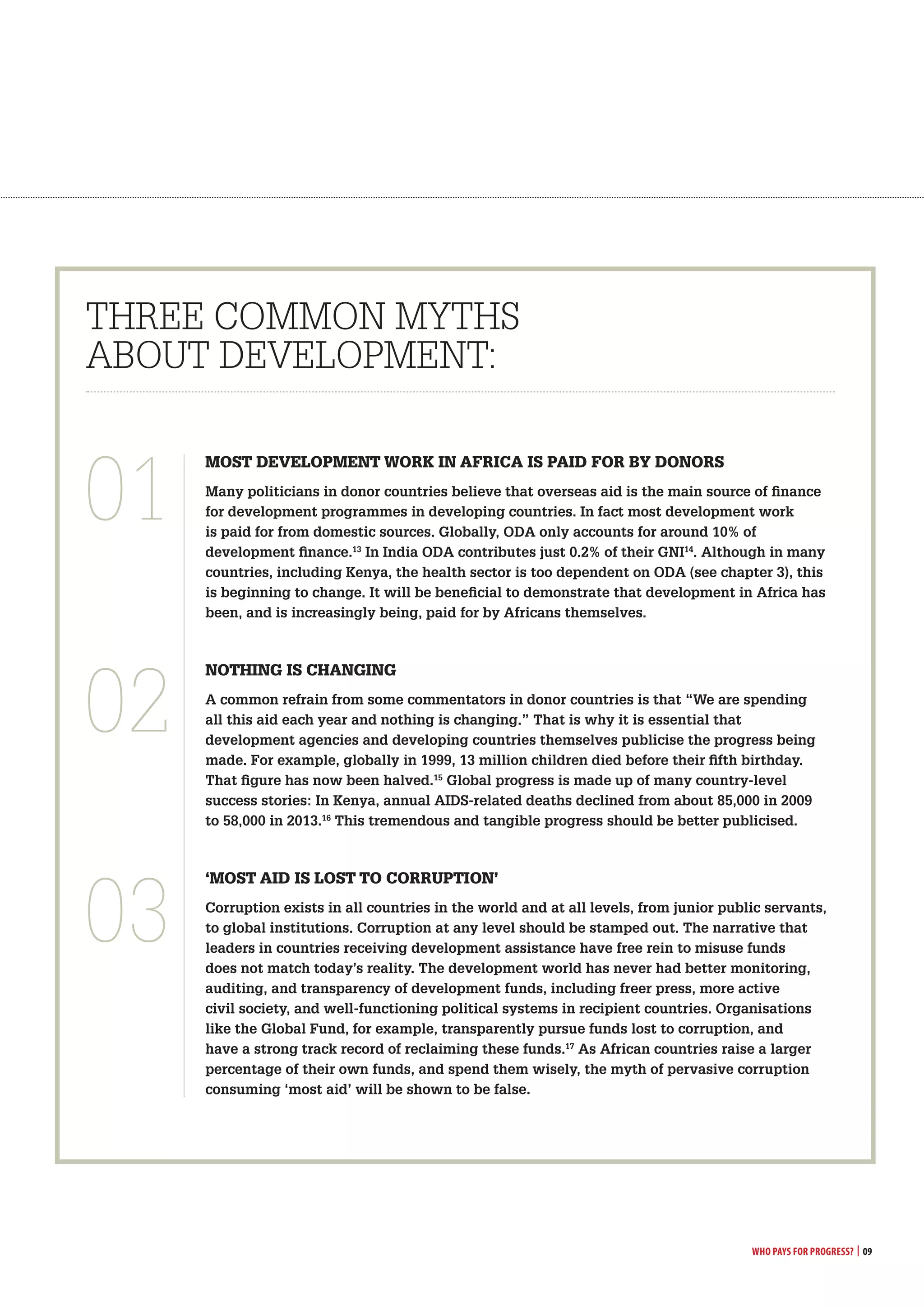
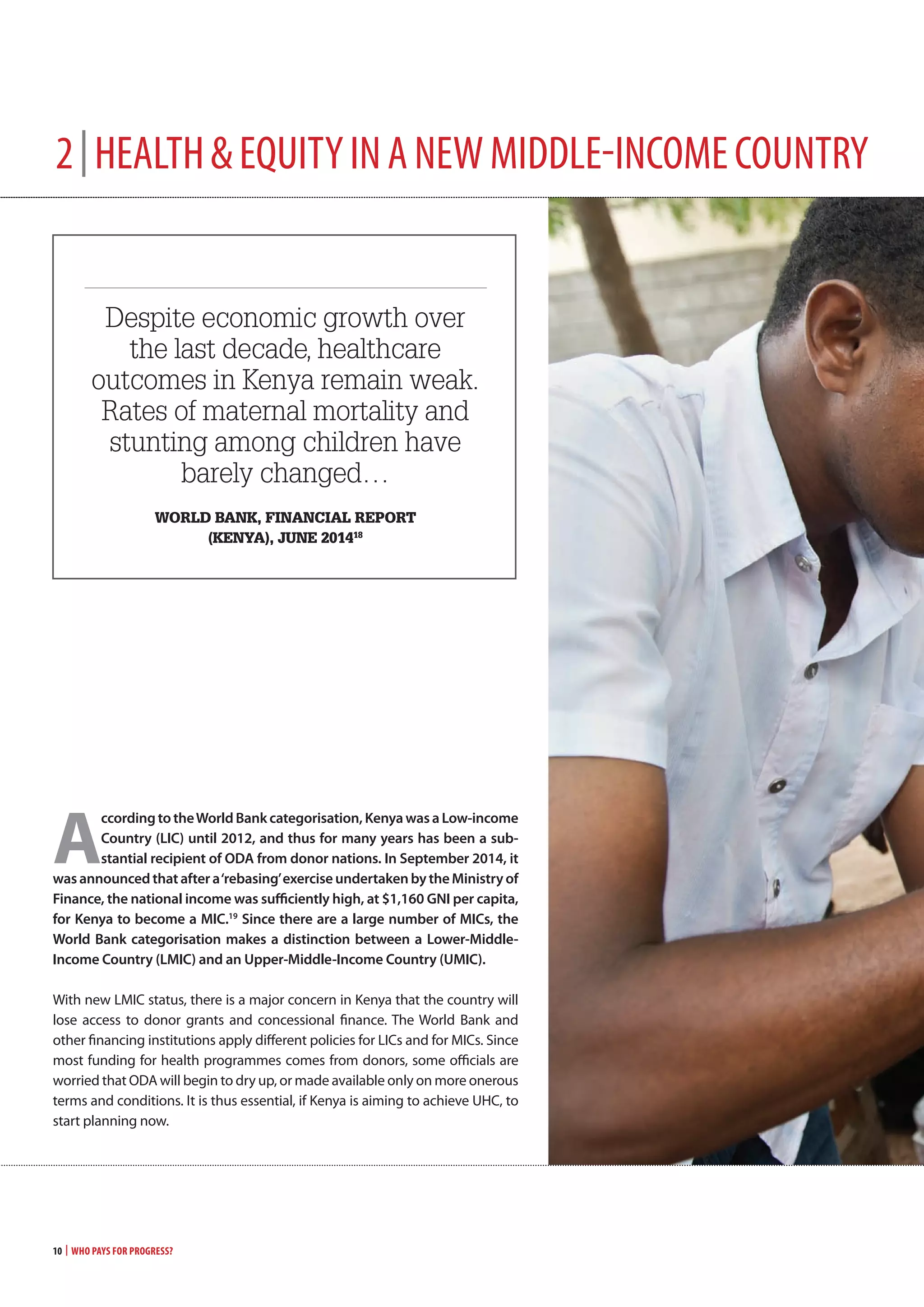
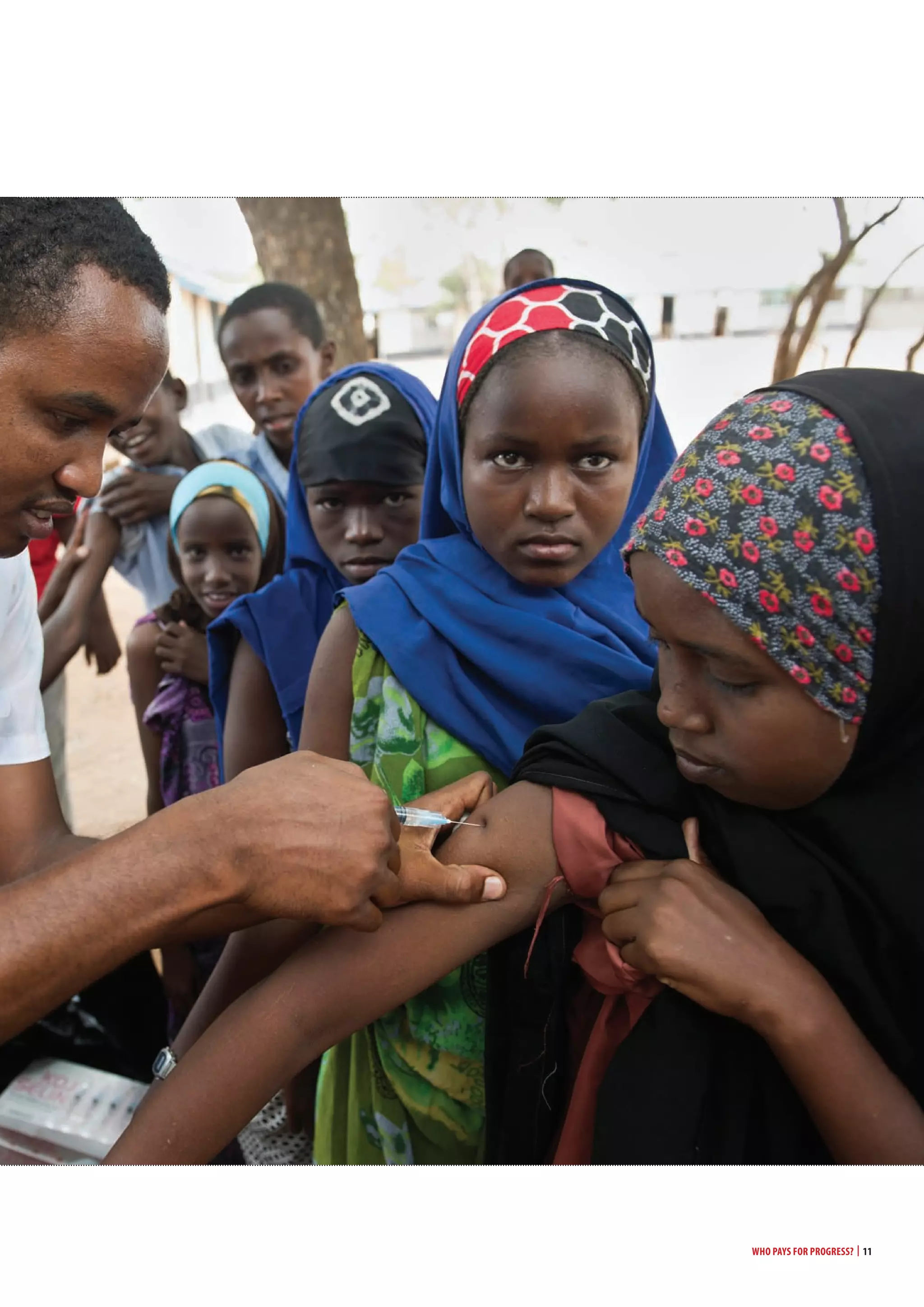
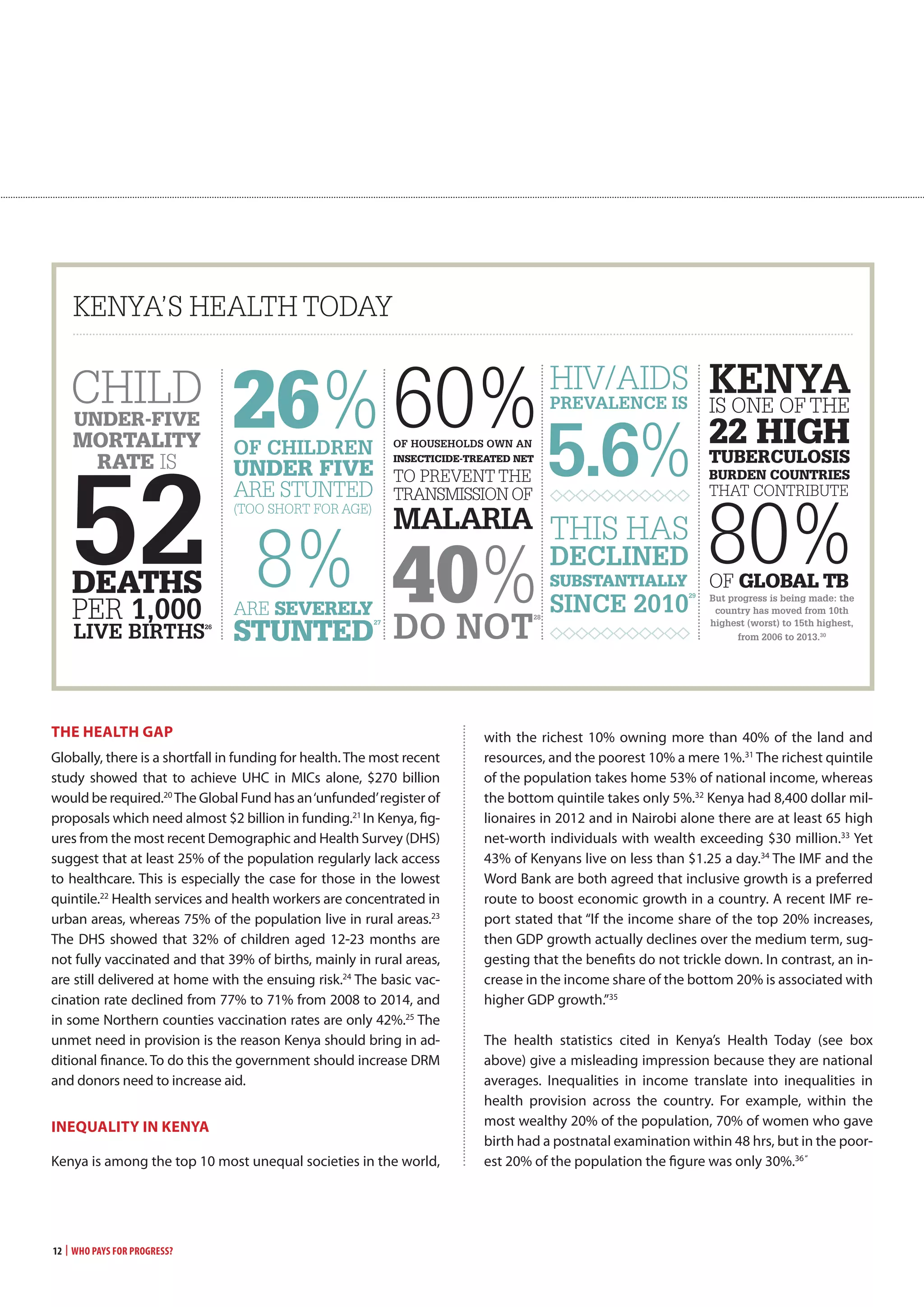



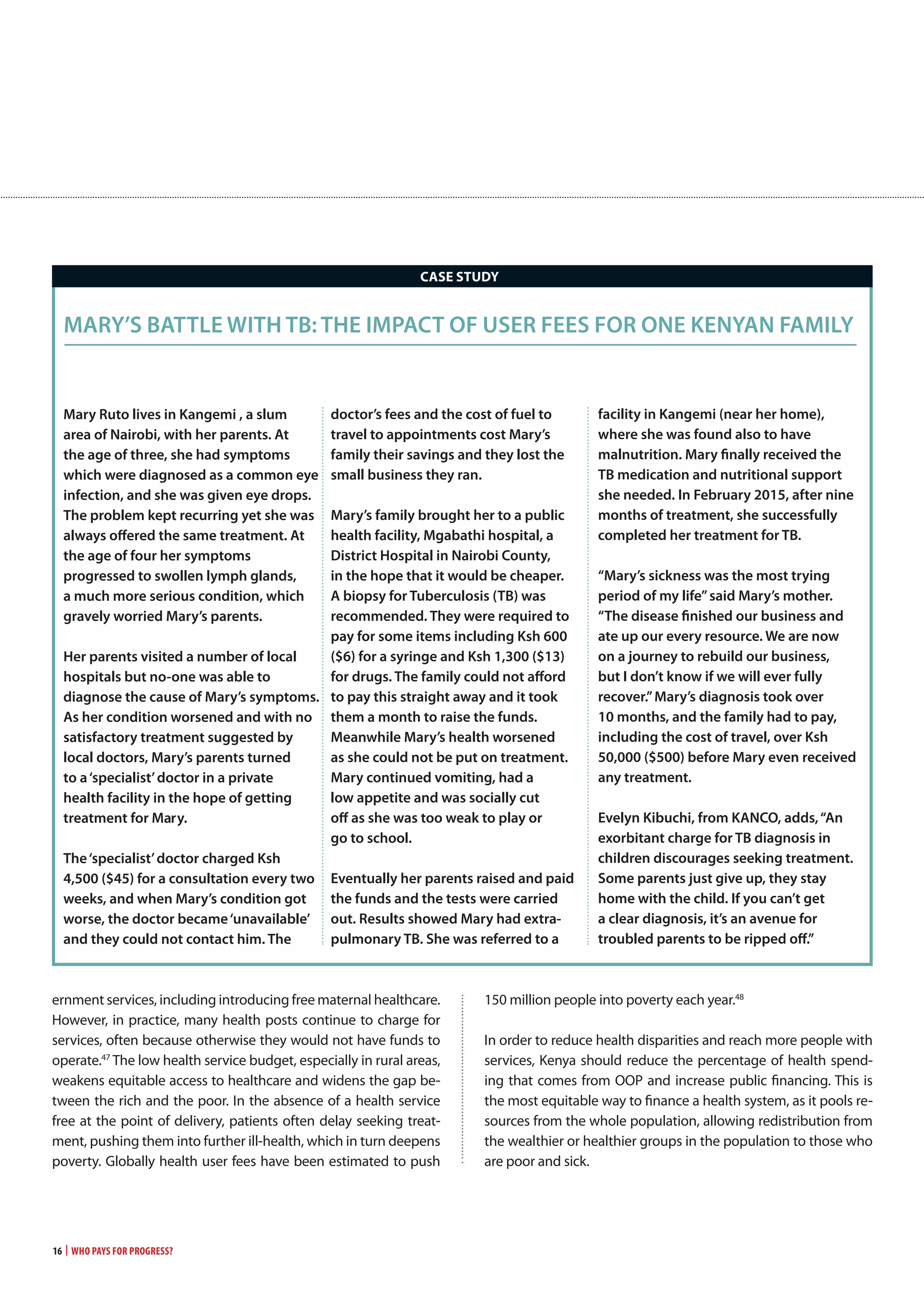
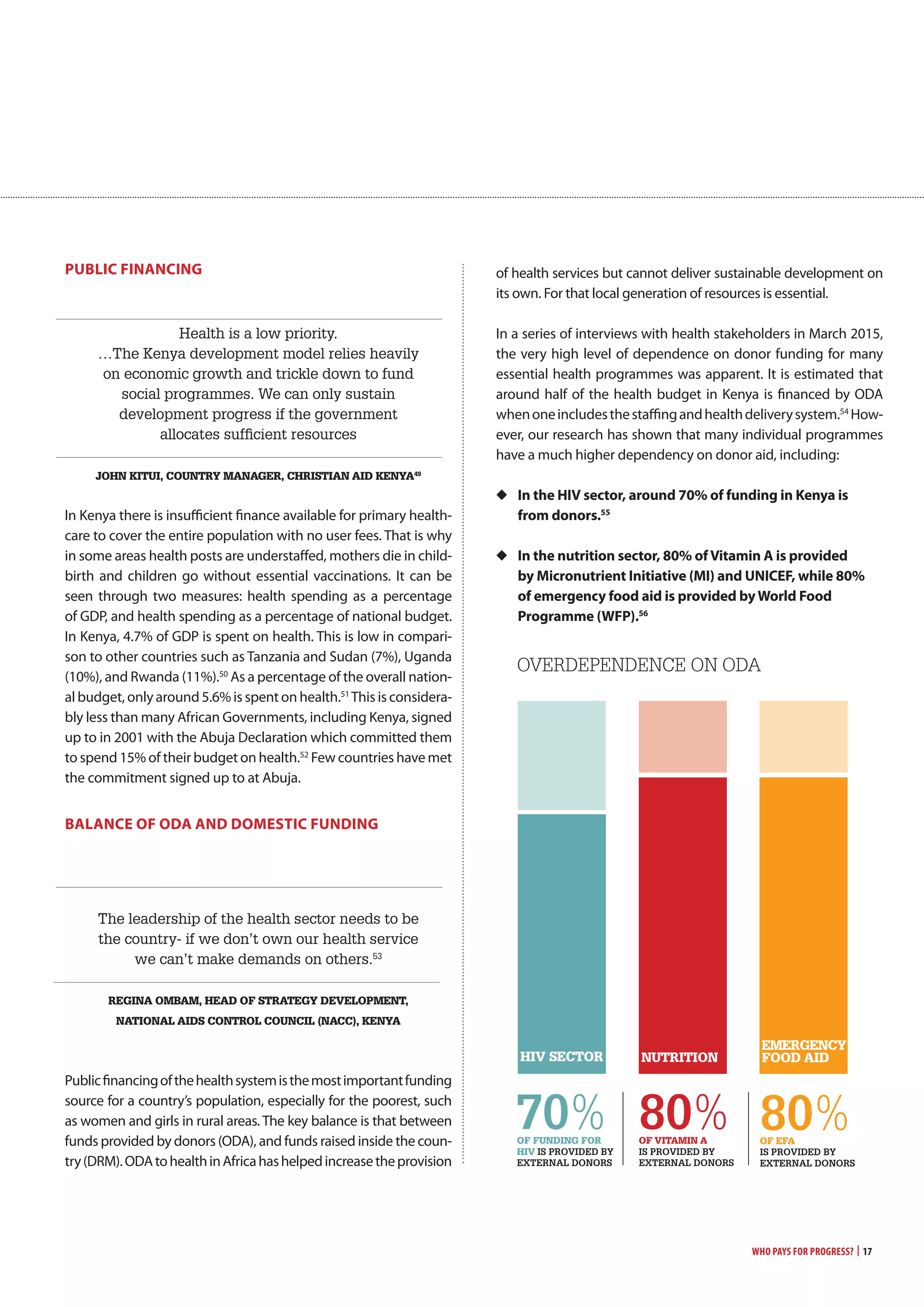




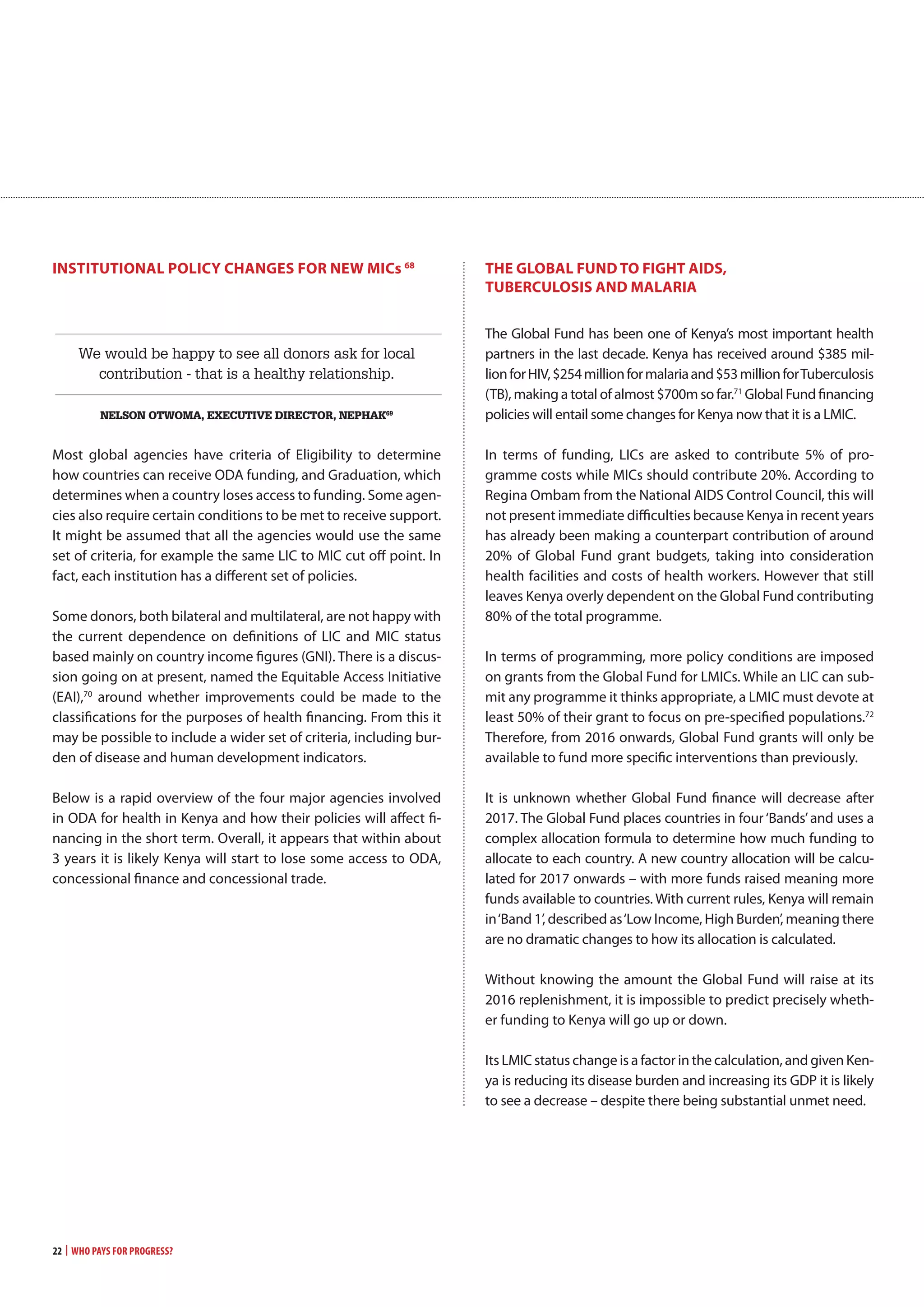



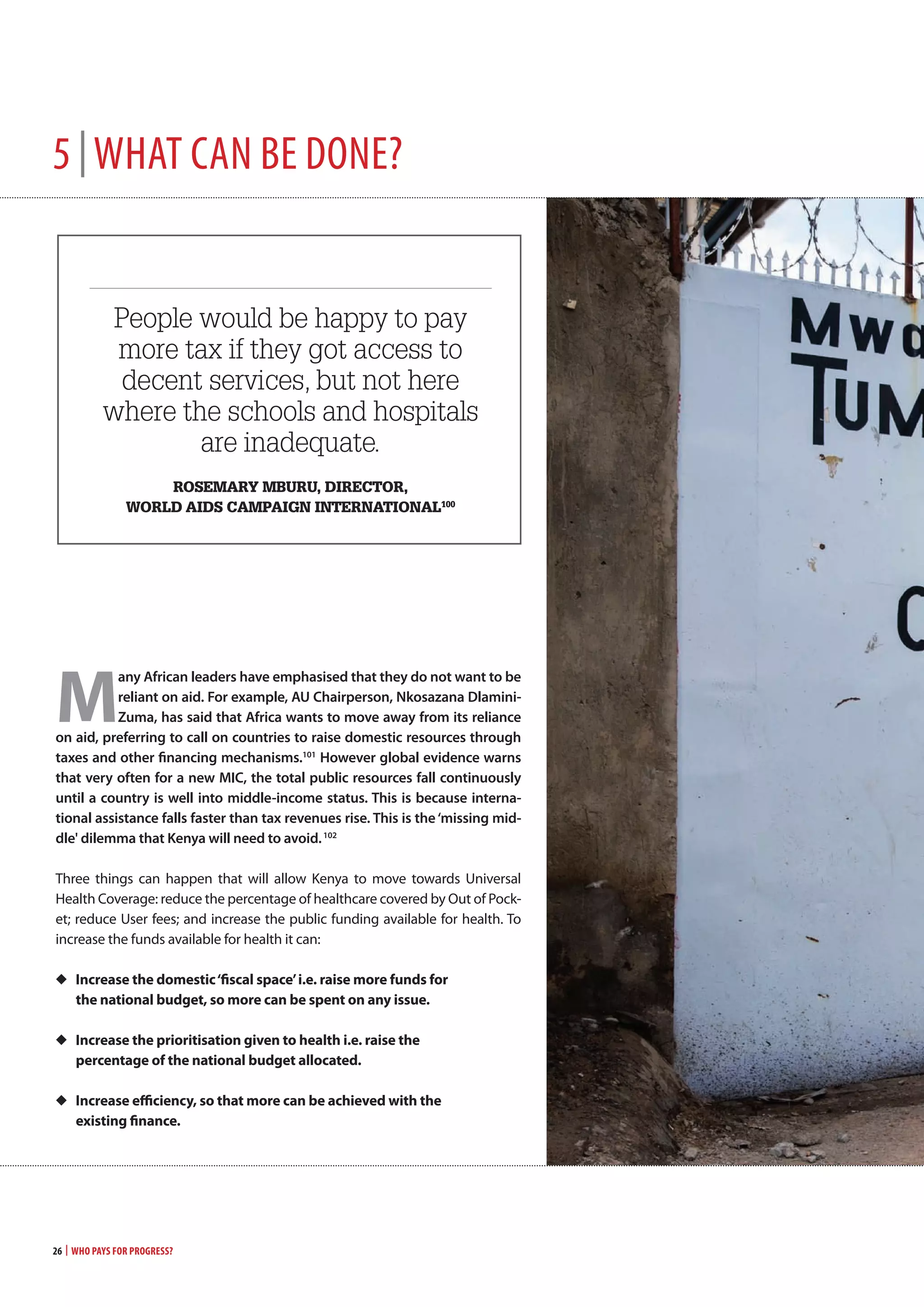
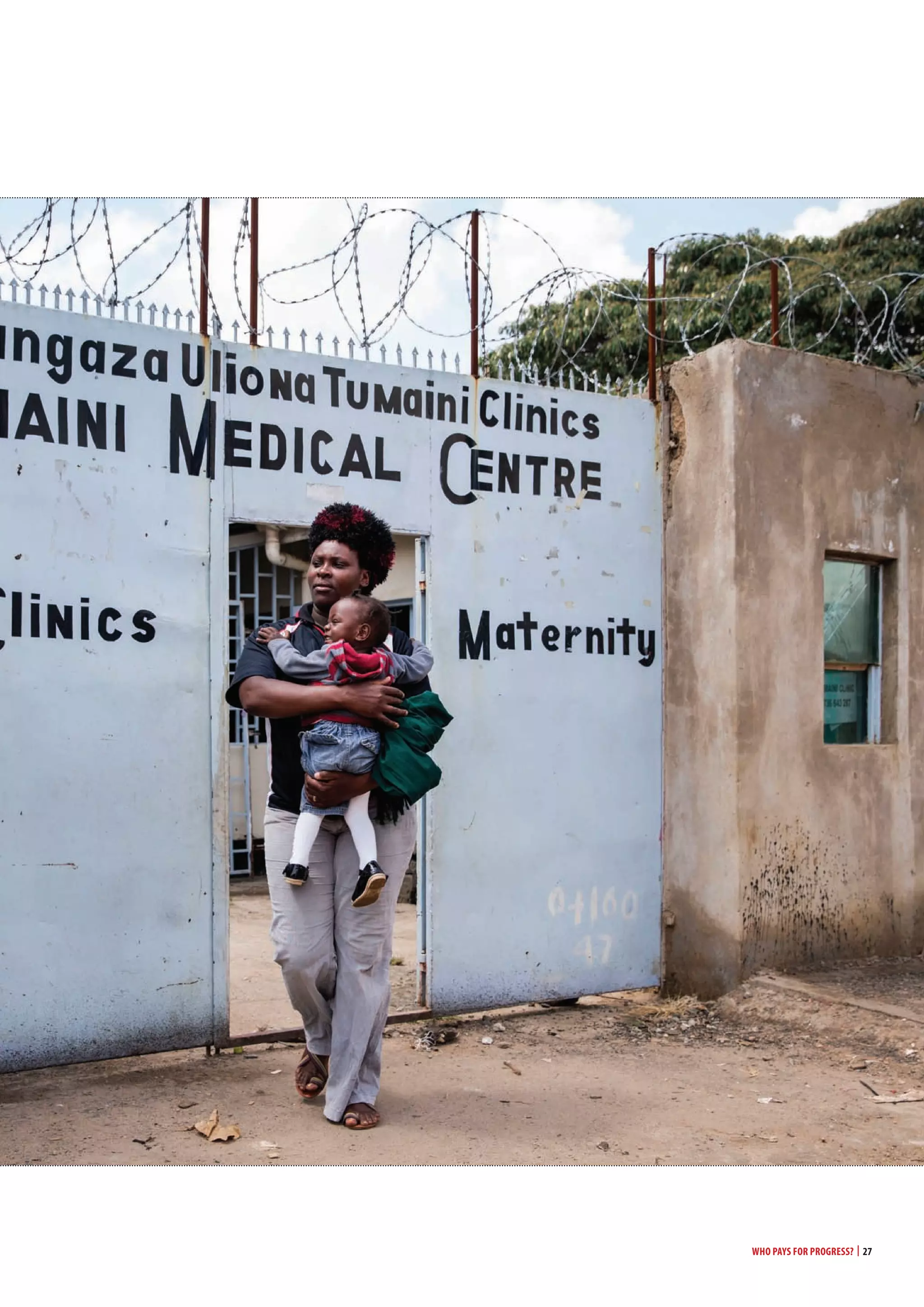

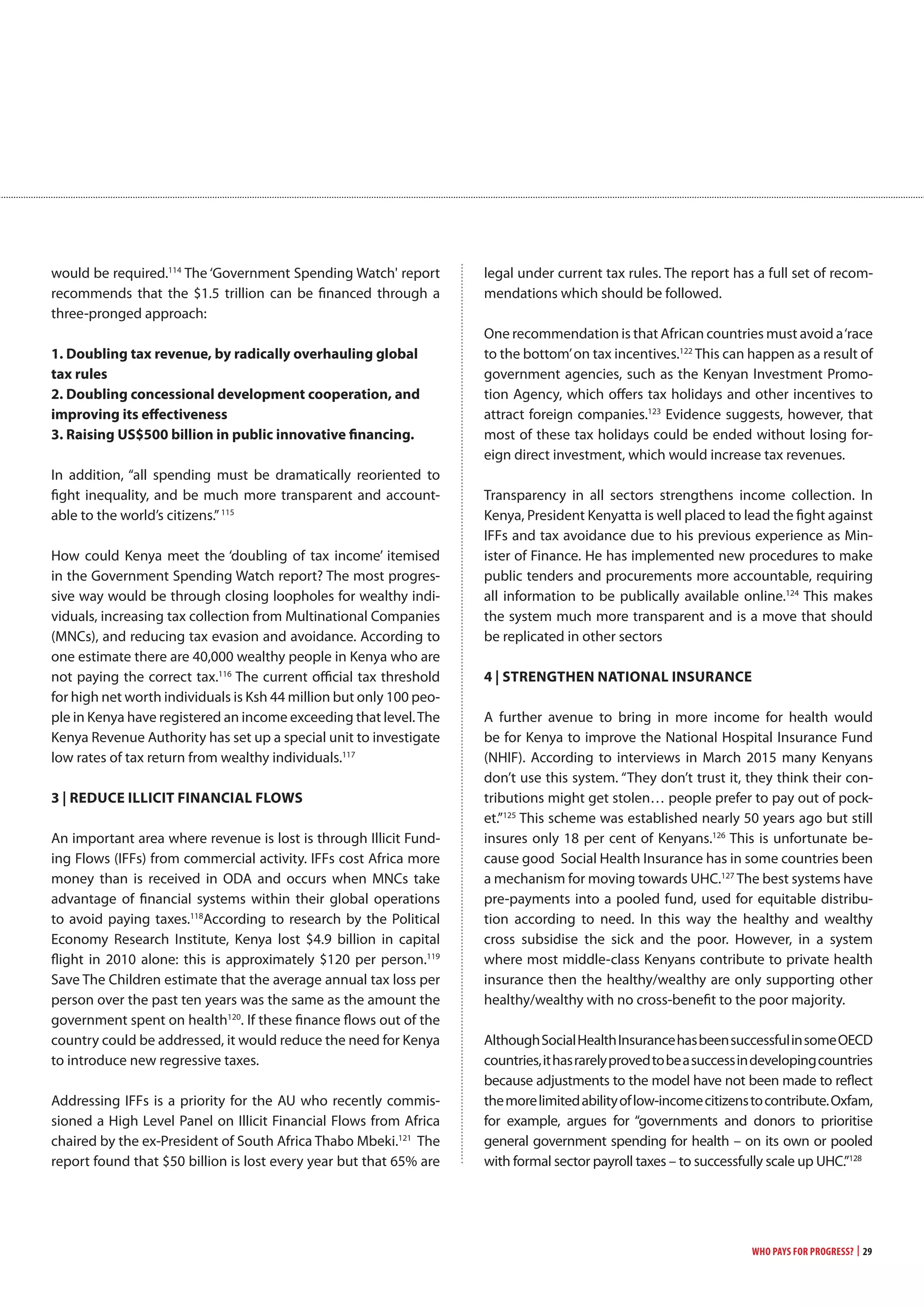



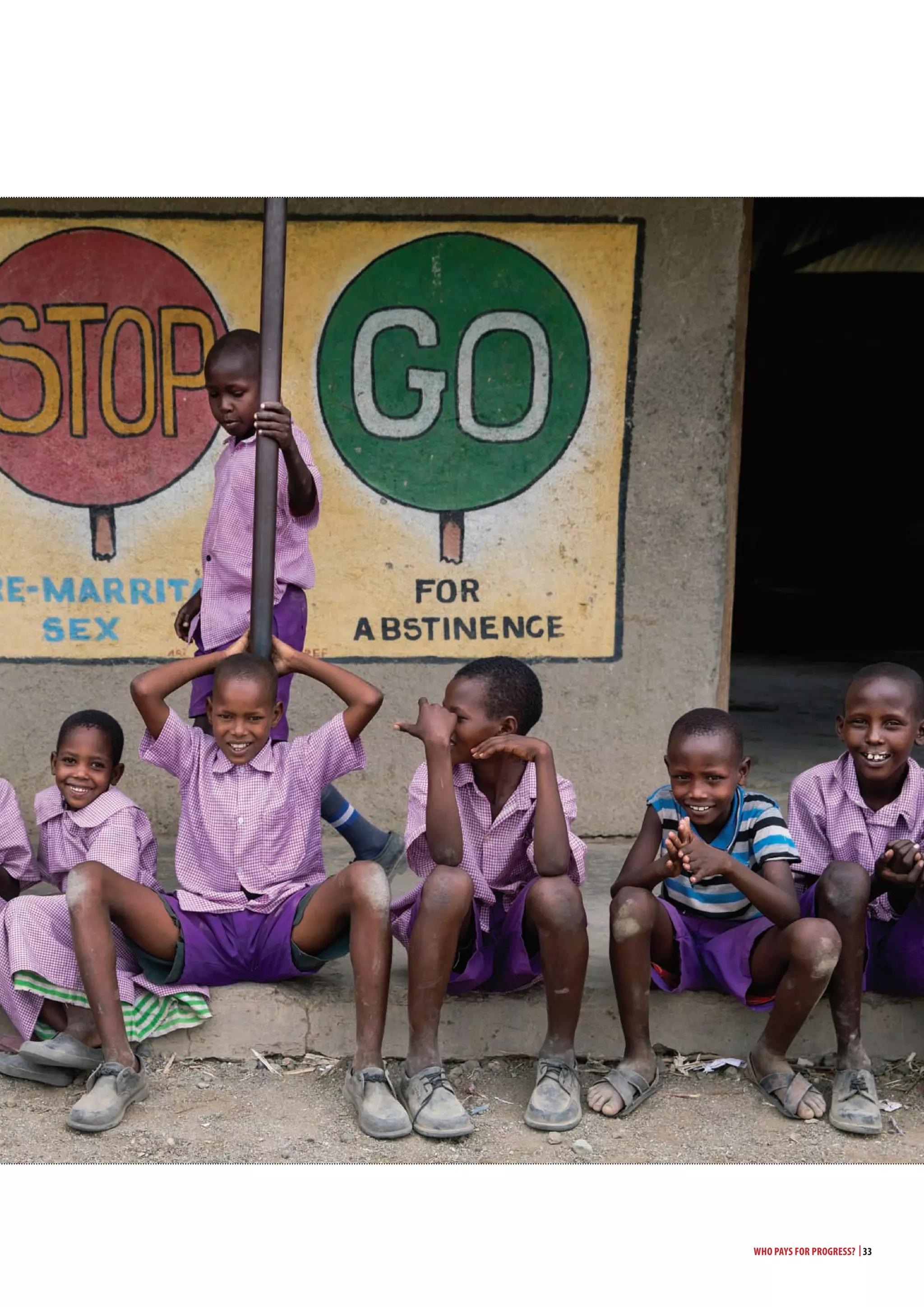

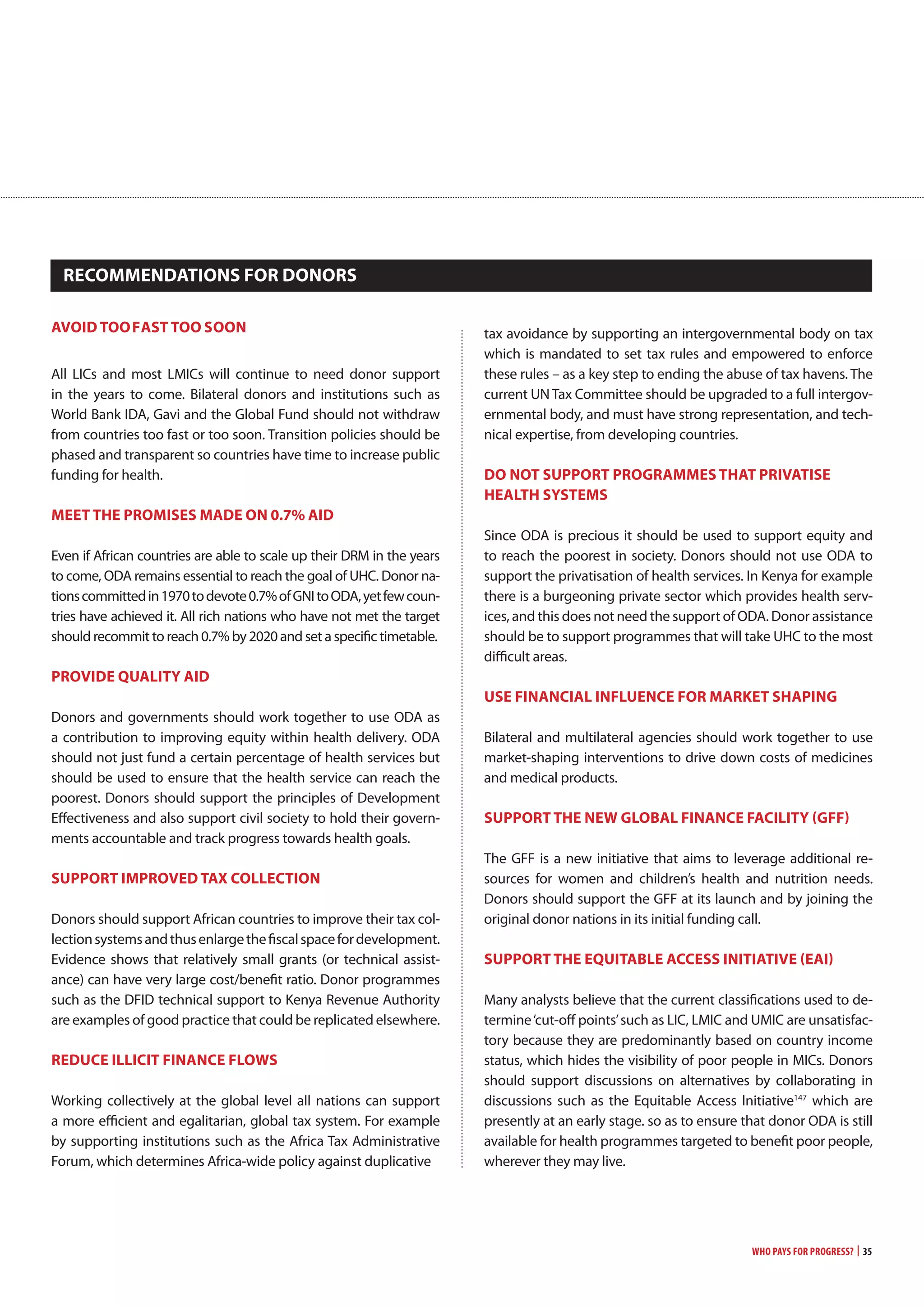
![36 | Who Pays for Progress?
references
1 Interview in Kenya, March 2014
2 World Bank, Kenya: A Bigger, Better Economy, 30 September 2014
3 Human Development Report 2014, Explanatory Note, page 2 and UNDP, Human
Development Report Kenya Country Profile
4 KDHS 2014, page 32 and 35
5 In this report the acronym ‘ODA’ may replace ‘donor funding’ or ‘aid from donor
countries’ or ‘concessional donor assistance’. DRM may mean Domestic Resource
Mobilisation or Domestic Revenue Mobilisation.
6 UHC describes a system where all people receive the good quality health services they
need without suffering financial hardship and that preventative and curative services
deliver improved health of all. WHO Fact Sheet on Universal Health Coverage available at
http://www.who.int/mediacentre/factsheets/fs395/en/ (accessed 16.06.15)
7 The Lancet, Global Health 2035: a world converging within a generation, The Lancet
Commission, Vol. 382, page 1931
8 His Excellency, President Uhuru Kenyatta of Kenya, during the General Debate, United
Nations General Assembly, September 24 2014
9 For example, Kenya is the number one recipient of Japanese ODA, and the sixth highest
recipient of ODA from the UK and the United States.
10 KDHS 2014, page 22
11 His Excellency, President Uhuru Kenyatta of Kenya, United National General Assembly,
September 2014
12 UK Independence Party Manifesto 2015, page 8
13 Alex Evans, Senior Fellow, New York University Centre of International Cooperation,
The Guardian, Who’s going to cough up the cash to meet global poverty targets?, 17th
February 2015 available at http://www.theguardian.com/global-development/2015/
feb/17/global-poverty-targets-sustainable-development-goals-financing (accessed
17.06.15)
14 Lorenzo Piccio, Devex, India’s Foreign Aid Program Catches Up with its Global
Ambition, 10 May, available at https://www.devex.com/news/india-s-foreign-aid-
program-catches-up-with-its-global-ambitions-80919 (accessed 16.06.15)
15 The United Nations, The Millennium Development Goals Report 2014, page 5
16 Kenya Ministry of Health, Kenya Aids Response Progress Report, 2014, page 10
17 As an example, The Global Fund website, Audits and Investigations, available at http://
www.theglobalfund.org/en/oig/reports/ (accessed 16.06.15)
18 World Bank, Kenya Economic Update, Take-off Delayed? Kenya’s economy facing
headwinds in 2014 with a special focus on delivering primary health care services, June
2010 Edition No. 10, page 7
19 World Bank, Kenya: A Bigger, Better Economy, 30 September 2014
20 ODI, Financing the Future: How international public finance should fund a global
social compact to eradicate poverty, April, 2015, page 42
21 The Global Fund website, Global Fund Register of Unfunded Quality Demand, available
at http://www.theglobalfund.org/en/uqd/ (correct on 03.06.15)
22 Author estimate based on KDHS 2014. Taking into account: 27% unmet need for
family planning (single women); 10% of women had no access to ante-natal care; 42% of
women had inadequate access to ante-natal care; 40% of women did not give birth in a
health facility; 30% of women did not receive tetanus protection after last live birth; 49%
of mothers did not receive post-natal care within 2 days of birth; 30% of children are not
fully immunised; 26% of children are stunted and 8% severely stunted; 41% of households
do not have a malaria net; 29% of men have not had an HIV test.
23 World Bank. World Development Indicators – Urban Population (% of total) (accessed
16.06.15)
24 KDHS 2014, page 32
25 KDHS 2014, page 32
26 KDHS 2014, page 22
27 KDHS 2014, page 35
28 KDHS 2014, page 40
29 Kenya Ministry of Health, Kenya Aids Response Progress Report 2014, page 4
30 WHO, Global TB Report 2014, Table 2.1
31 Christian Aid website, available at http://www.christianaid.org.uk/whatwedo/africa/
kenya.aspx (accessed 16.06.15)
32 UNICEF, Global Inequality: Beyond the Bottom Billion. A Rapid Review of Income
Distribution in 141 Countries, April 2011, page 55
33 World Wealth Report Interactive Tool available at https://www.worldwealthreport.
com/reports/hnwi_population/africa (accessed 16.06.15)
34 DFID DevTracker, Kenya Country Profile, available at http://devtracker.dfid.gov.uk/
countries/KE/ (accessed 16.06.15)
35 IMF Causes and Consequences of Income Inequality: A Global Perspective. June 2015
36 KDHS 2014, page 27
37 Kenya Ministry of Health, Kenya Nursing Workforce Report: The Status of Nursing in
Kenya, 2012, page 8
38 World Bank, Kenya Economic Update - Take-off Delayed? Kenya’s economy facing
headwinds in 2014 with a special focus on delivering primary health care services, June
2010, Edition No. 10, page 7
39 Sustainable Development Solutions Network, Financing Universal Health Coverage in
the Post-2015 Agenda, Issue Brief, 24 February 2015, page 1
40 Kenya Integrated RMNCAH Investment Framework presentation presented at Global
Financing Facility RMNCAH consultative meeting at the Panafric Hotel 30 April 2015.
41 ‘Full income’ combines growth in national income (GDP) with the value people place
on increased life expectance – the value of their additional life years. The Lancet, Global
Health 2035
42 International Food Policy Research Institute, Global Nutrition Report 2014: Actions and
Accountability to Accelerate the World’s Progress on Nutrition, 2014, page 8
43 The Lancet 2013, Global Health 2035, page 1913
44 World Bank Group President Jim Yong Kim’s speech at World Health Assembly, Poverty,
Health and the Human Future, 21 May 2013
45 Countdown to 2015 (2013) Kenya Country Profile
46 Government Spending Watch, Financing the Sustainable Development Goals: Lessons
from Government Spending on the MDGs, April 2015, page 33
47 “For public dispensaries and health centres fees are about Kshs.20 [$0.22] and then pay
for some drugs that are not available for free, and for the specialised tests e.g. x-rays. So
health costs are subsidised, but for the really poor this is still high for them.” NGO worker in
Nairobi. Interview in Kenya, March 2015
48 WHO Fact Sheet on Universal Health Coverage
49 Interview in Kenya, March 2015
50 Figures for 2013. World Health Organization Global Health Expenditure database
(correct on 25.05.15)
51 The figure is unclear, partly because of the devolution process. The amount spent on
health in the national budget is complicated by the devolution of responsibilities and
budgets being carried out in the country at present. Two years ago Kenya embarked on
what the World Bank described as ‘one of the most ambitious devolution programmes of
any country in the world’. Devolution to 47 counties makes the gathering of much data
in the health sector more difficult than it used to be with a centralised national system.
Please see: World Bank website, News, Public Participation Key to Kenya’s Devolution, 30
April 2015
52 Abuja Declaration on HIV/AIDS, Tuberculosis and other Infectious Diseases agreed
at the African Summit on HIV/AIDS, Tuberculosis and other Infectious Diseases, Abuja,
Nigeria, 24-27 April 2001
53 Interview in Kenya, March 2013
54 WHO, Global Health Expenditure Database (accessed 16.06.15)
55 Interview with Regina Omban at the National AIDS Control Council (NACC) Kenya,
March 2015. Also see: Friends of the Global Fight against AIDS, Tuberculosis and Malaria
(GFAN), Innovation for Greater Impact: Exploring Resources for Domestic Health Funding
in Africa, 2014, page 11](https://image.slidesharecdn.com/a4f2910c-0195-4e29-9647-5e15290ad03b-161220153349/75/Who-Pays-for-Progress-36-2048.jpg)

